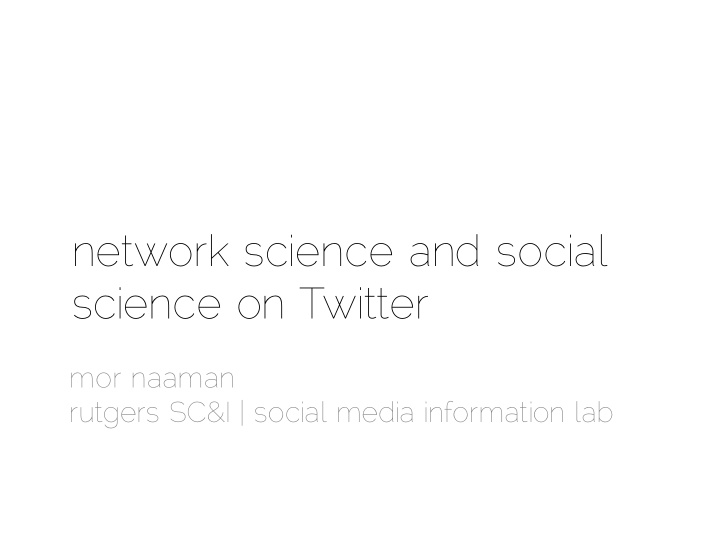



network science and social science on Twitter mor naaman rutgers SC&I | social media information lab
social media information lab?
social media research: 1. what are people doing (and why)?
social media research: 2. understanding social systems at scale
social media research: 3. creating new experiences
Social ¡media ¡ Document ¡feature ¡ Event ¡clusters ¡ documents ¡ representa/on ¡
Mult Multipla iplayer (w/ Coco) er (w/ Coco)
vox vox civi civitas tas
social media awareness streams networks
today’s big story generate a better understanding of the social dynamics validate theories from social sciences in these new and important settings
today’s more specific story Twitter and networks: rt 1 . social sharing of emotion and Pa Part 1 networks on Twitter rt 2. unfollowing on Twitter Pa Part 2.
study 1 emotion & social networks Kivran-Swaine & Naaman. Network Properties and Social Sharing of Emotions in Social Awareness Streams. (CSCW 2011 ).
main question How does users’ social sharing of emotion in SAS relate to the properties of their social networks? picture by paloaltosoftware
research questions RQ1 What is the association between people’s tendency to express emotion (joy, sadness, other) in their posts (updates or interactions) and their number of followers?
research questions RQ2 What is the association between people’s tendency to express emotion (joy, sadness, other) in their posts (updates or interactions) and their network characteristics like density and reciprocity rate?
1.5 step ego-centric network
in graph language G(V, E) directed graph (v i , v j ) there is edge from v i , to v j edge is reciprocated if (v i , v j ) and (v j , v i )
in graph language density of network around v i is defined as: |E i | / |N i | * |N i -1| where N i = {v j | (v i , v j ) or (v j , v i )} E i = {(v j , v k ) | v j in N i or v k in N i } (really, clustering coefficient)
1.5 step ego-centric network
data content dataset from Naaman, Boase, Lai (2010) social network dataset from Kwak et al. (2010) 105,599 messages from 628 users who: had no more than 5,000 followers or followees posted at least one Twitter update in July 2009 in English still had public profile in April 2010
pilot study joy on average 23% of a user’s updates “Fireworks at the Cumming fairgrounds were “Just snagged last copy of wii sports resort. Yay!” awesome. Sophia had a blast. Lucy said, “ooooh,” over and over. Good times with my family.!” sadness on average 10% of a user’s updates “RIP Kathy. Live life for today. You never know how long you have.!”
study details automated analysis of the users’ tweets based on LIWC “expression of emotion” => “existence of emotive words”
some gender differences joy sadness other emotions
analysis independent variables: yay ! @follower … joy (updates-interactions) sadness (updates-interactions) emo (updates-interactions) 3 linear regression models for dependent variables: number of followers network density reciprocity rate
results … explaining number of followers (R 2 = .22) joy-interactions .35 ** @follower … sadness-interactions .20 ** @follower … ** p < .01
limitations & future work better (real) emotion classifier improve sampling, increase dataset culture dependent dyad-level analysis
today’s more specific story Twitter and networks: rt 1 . social sharing of emotion and Pa Part 1 networks on Twitter rt 2. unfollowing on Twitter Pa Part 2.
study 2 unfollowing on Twitter Kivran-Swaine, Govindan & Naaman. The Impact of Network Structure on Breaking Ties in Online Social Networks: Unfollowing on Twitter. (CHI 2011 ).
blue=unfollow
main question: what structural properties of the social network of nodes and dyads predict the breaking of ties (unfollows) on Twitter?
theory background tie strength embeddedness within networks power & status
data content dataset from Naaman, Boase, Lai (2010) social network dataset from Kwak et al. (2010) Twitter API – connections still exist 9 months later? 715 seed nodes 245,586 “following” connections to seed nodes 30.6% dr een 07/2009 & 04/2010 30.6% dropp opped b d betw etween 07/2009 & 04/2010
analysis * independent variables (computed for our 245K dyads) seed properties follower-count, follower-to-followee ratio, network density, reciprocity rate, follow-back rate follower properties follower-count, follower-to-followee ratio dyad properties reciprocity, common neighbors, common followers, common friends, right transitivity, left transitivity, mutual transitivity, prestige ratio
<disclaimer> the following figures are NOT scientific evidence and are shown here for illustration purposes no control for intra-seed effects; no inter-variable effects no R installation was harmed in the making of the following figures
effect of number of followers (none):
effect of reciprocity (large):
effect of follow-back rate
effect of common neighbors
</disclaimer> back to scientific results (made R break sweat) sparing you most details, though
in-depth analysis multi-level logistic regression (dyads/edges nested within seed nodes) three models; full one includes seed, follower, and dyadic/edge variables complete details: in the paper
some results effect of tie strength on breaking of ties *** dyadic reciprocity (-) *** network density (-) *** highly statistically significant
limitations & future work only two snapshots: add more additional (non-structural) variables (e.g., frequency of postin g!) emotion and tie breaks
meanwhile, in computer science algorithms to predict tie breaks? how do tie breaks impact network dynamics?
relationships interests activities culture language physical spaces
NYC vs. W NYC vs. Washi ashingto gton DC n DC
thank you mornaaman.com mor@rutgers.edu @informor http://bit.ly/MorInfoSeminar come work wi th us! rutgers SC&I social media information lab
Recommend
More recommend